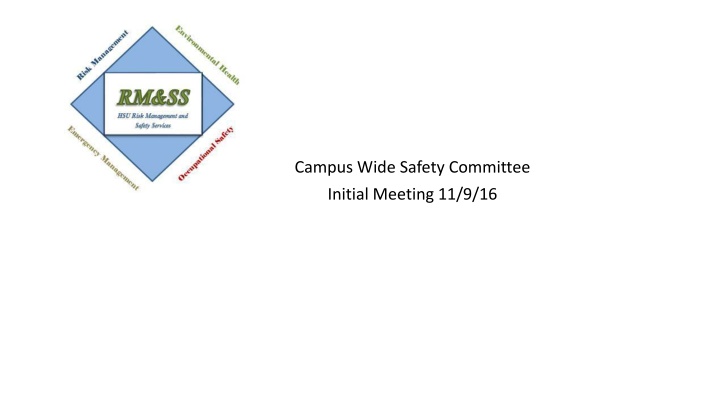
Campus-Wide Safety Committee Meeting: Risk Management and Evaluation
Learn about the risk management practices at Humboldt State University, including identifying, evaluating, and controlling various risks to protect the campus community and its mission. Explore types of losses, how to anticipate and identify risks, and the criteria for risk evaluation.
Download Presentation

Please find below an Image/Link to download the presentation.
The content on the website is provided AS IS for your information and personal use only. It may not be sold, licensed, or shared on other websites without obtaining consent from the author. If you encounter any issues during the download, it is possible that the publisher has removed the file from their server.
You are allowed to download the files provided on this website for personal or commercial use, subject to the condition that they are used lawfully. All files are the property of their respective owners.
The content on the website is provided AS IS for your information and personal use only. It may not be sold, licensed, or shared on other websites without obtaining consent from the author.
E N D
Presentation Transcript
Campus Wide Safety Committee Initial Meeting 11/9/16
Risk Management Define Types of losses How to anticipate and identify risks How to evaluate How to implement control Control Techniques Risk Matrix
Common Definition The risk management practices of Humboldt State University are specifically designed to identify and assess all types of risk to the campus, and to implement appropriate risk management techniques in order to protect the university so it can carry out its mission. It is the goal of Risk Management and Safety Services to aid in the identification and evaluation of risk, to facilitate the selection and application of the best risk management techniques to mitigate risks, and to monitor the results.
Types of losses Death, injury or inappropriate treatment of employees, students and guests Physical damage to university property Loss of campus revenues due to property damage Liability claims against the university due to damage to non-university property Losses resulting from fraud or criminal acts
How to anticipate and identify risks Review and assess workers compensation claims and employer s report of occupational injury or illness documents Campus safety inspections Investigate accidents and near misses Investigate and assess reported safety hazards Review allegations of inappropriate treatment of student, faculty, staff and visitors Review and evaluate, as appropriate, student activities including academic field trips, projects, high hazard experiments, travel abroad, sanctioned activities, etc.
Evaluation Identify risks which pose a potentially precedent-setting, broad or major impact to the university to be evaluated Criteria Severity The amount of human harm or property loss that can occur Frequency of Exposure How often the event or activity takes place Predictability the ability to anticipate losses associated with specific activities or conditions Probability The actuarial chance of a loss
Implement Control The liability exposure the campus and the CSU faces for activities linked to the mission of the CSU can be mitigated in variety of ways: Transferring risk through third party waivers, hold harmless agreement, vendor contracting or by purchasing personal liability, health, travel and life insurance Reviewing and recommending specification for insurance purchases for the university Preventing/controlling risk through staff training and supervision Implementing internal controls Redesigning processes and systems Monitoring health and safety compliance Conducting internal audits
Control Techniques Avoidance Loss prevention and reduction Risk transfer






















